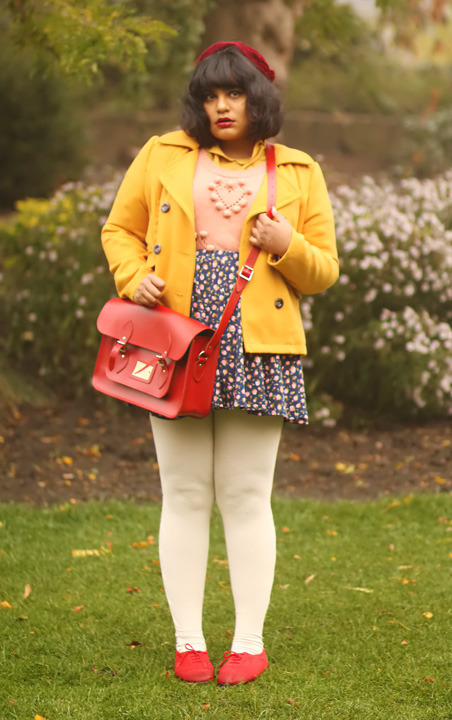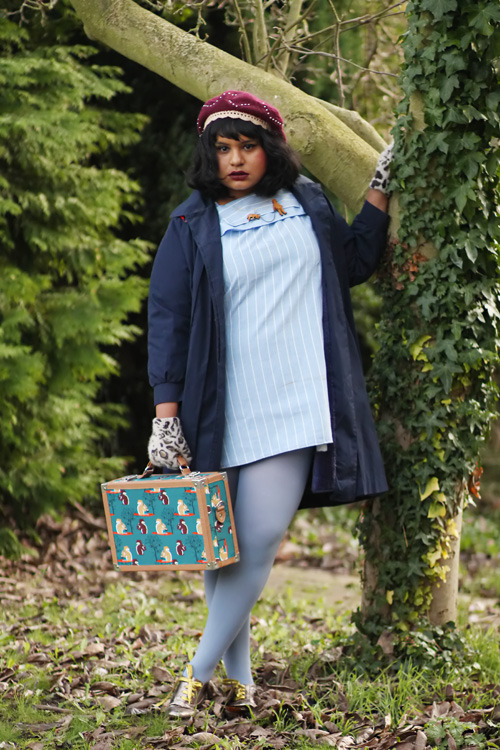My favourite pastime as a kid was drawing – there were very few things I liked better than the time spent with my massive crayon set spread out in front of me, scribbling singlemindedly on a piece of paper. Growing up in a house where TV, games, films and music were banned, books and drawing were my only sources of entertainment, and I used them to their fullest potential. I still remember the first self portrait I drew. I would have been around 5 at that time, well past the Lacanian mirror stage, and aware of who I was. My first self portrait featured a girl with blonde hair and blue eyes, just like my countless other drawings inspired by the pictures I saw in the books I read.
They were books written for little white girls and boys in the 20’s, 30’s and 40’s – mostly Enid Blyton’s hack writing, supplemented by Soviet children’s literature and the occasional picture book of stories from unlikely places like Eastern Europe. My parents were odd in this regard – odd and pathological, although I know that they did what they did because they thought it would be good for me. You see, they never let me identify as an Indian child. I wonder why this was – they had been born in post-independence India, and yet they displayed all the classic signs of colonial trauma. Their endless self depreciation as Indians tempered by “the West is evil/ greedy/ perverse” rhetoric made for some very confusing messages directed at baby me. At the root of it lay the fact that my parents weren’t comfortable identifying as Indian – for them India was an embarrassment they had to live with, and they did everything they could to deny this essential fact about themselves – their race. I remember how my dad used to tell me that I looked Middle-Eastern and be proud about it, and I remember one singular occasion at the Indian Museum, when my mother encountered a white tourist. The museum staff didn’t have enough English to explain to her that photography wasn’t allowed there, and so my mother chipped in to help. I remember how for the next 10 minutes or so, as we walked through the dusty corridors, she mouthed the words “You can’t take photos here” to herself, embarrassed that she might have gotten something wrong with that simplest of sentences, mortified that she might have appeared ill-educated to the tourist, who, as far as I recall, had been nothing more than bewildered and later, thankful for the situation being explained to her. I also remember how, when our neighbour’s US-dwelling cousins came over to visit, my mother would make fun of their accents and lifestyle. It was a classic case of the old depersonalisation that happens with every colonial subject.
We want to be them, but at the same time, we want to be us. How do you strike a balance, and can a balance at all be struck? As a child, I was too young for these questions; instead what I took back was that I needed to be white. Being white was my ultimate goal in life. I wanted the pale skin, the sharp features, the light hair and eyes – and I wanted the peter pan collars, and the pinafores and the t-strap mary janes. England, to me, (because it was England, all of it, what else could it be?) was a place filled with boarding schools, midnight feasts, cosy farms, brooks and dales and copses (unfamiliar words I hastened to incorporate into my vocabulary and writing), fantastical foods I had never seen in my life and pretty blue-eyed children who went off on glorious adventures in their pinnies and jelly shoes. I was a fat, socially awkward Indian kid in boys’ clothes – yet in my head, my eyes were blue, my unruly black hair tamed into a cute chocolate brown bob, and my clothes straight out of a 40s catalogue. I remember my excitement and joy when my mother passed on to me an old cape of hers – it was pastel green with a dusky pink lining, and I never wanted to take it off. To me it represented all my dreams of being a pretty white child, all the dreams I had no way of fulfilling.
Of course, I grew up and the England in my head changed as well. From Enid Blyton’s whitewashed adventure stories, I graduated to the William books, and eventually to the Adrian Mole books, Roddy Doyle and Irvine Welsh. This was a different England/Ireland/Scotland – an uniformly grey world of fish finger sandwiches and chip teas, of unemployment and the dole, of domestic violence and junkies. But I was still fascinated. My obsession with 60s London in my mid teens served to fuel it further. I wanted to see London, I wanted to see Cambridge and lie around in Grantchester Meadows watching the sun go down with the cute English boyfriend I would inevitably have. (As it turned out, I did make it to Cambridge, several times over, cute English boyfriend and all, but I never made it to Grantchester Meadows.) England was a dream and a hope, and one day I would be there, I resolved. I toyed with applying to East Anglia or York after my plus twos, but ended up in my local university, studying, what else? English Literature. And that’s where my life changed.
In my second semester as an undergrad, I encountered the fascinating and life-changing area of studies known as Postcolonialism. And that was when I began to realise exactly what had been going on in my head since I was 5. I finally had the tools I needed to unpack and analyse the stupefying amount of depersonalising violence and trauma I had been subject to from that tender age. Because violence and trauma were exactly what it had been. To take a child, a small child of colour who is just beginning to be involved with the world around her and send her messages that what she intrinsically is is not good enough, that in order to be deemed worthy, she must be someone she is essentially not – that, to me, is violence, violence against her inherent self. My self image hadn’t just been whitewashed – it was as if my very bones had been bleached blinding white from the inside. I had been rendered powerless, unable to even accept my own face as it was. I had spent my teenage years thinking I was ugly – not just because I was fat but because my features were too Indian. Studying Postcolonialism was my first step to reclaiming that power.
Do I still have issues with being Indian? Of course I do – that sort of conditioning is not easily undone in years, or in decades. But my self image is in a better place now than it ever has been, and I have been able to do this by subverting the power structure, by reclaiming power…through the way I dress. I have often said here, and elsewhere, that my style is mostly inspired by vintage childrens’ books – the very books I read as a child. The outfits I wear now are the outfits I wanted to wear back then, as an Indian child who desperately wanted to be white. I am no longer a child, nor do I want to be white – but wearing the clothes I wanted to wear is my way of taking back power – it’s my way of “writing” back, sartorially. Subversion and mimicry are two essential features of the colonial subject. It’s one way, and a very good way to take back power. When we, as brown people, engage in mimicry of the west, it is dismissed as mere “aping” (a loaded word, if there ever was any) but in reality, it is an incredibly powerful tool for reclaiming what’s ours. Mimicry is not blind copying – it is, by its very nature, subversive and seditious – the critic Homi Bhabha succinctly puts it as “almost, but not quite”. It is this “almost, but not quite” nature of mimicry that makes it so loaded. Because it creates gaps, spaces in the power structure that can’t be filled with the usual colonial rhetoric. And for me, these gaps can only be filled with the power we take back by engaging in mimicry.
When I dress like a child from one of the books I used to read, it’s an unsettling, disruptive sight. I’m a grown, fat, brown woman dressed like a white kid from the 40’s, the 60’s, or even the Victorian era. You don’t expect it – it comes a shock to your defined ideals of what a white child should be, in all its innocence and sanctity, when you see a fat brown woman, that symbol of voluptuous, dangerous Oriental sexuality dressed in the clothes that pretty white child should be wearing. And this is exactly the reaction I want, this is exactly why I’m doing this. It’s my way of reclaiming power, by disrupting notions of whiteness and brownness, of innocence, sexuality and what, as a brown woman, is “allowed” me. I am no longer content to occupy the space that I am allowed, I want to shatter those boundaries and take up the space I want. I want to take up space, I want to take up and take back the space that was never meant for me, because this is my way of saying “look, I exist, and I will not be content with the role you have set up for me as a postcolonial subject.” I want to invade sanctified spaces of whiteness, and my way of doing it is to take their children’s clothes and refashion it as mine. Colonialism erased my identity as a brown child, but now I’m here, and I will take back spaces reserved for whiteness, because they took away my voice when I was young. I have a voice now, one that is uniquely my own, and I will use it to carve out a niche for myself in their white, white world. I will wear my peter pan collars, my schoolgirl hats and my saddle shoes, and I will appropriate all the space they took away from me and my own, because now I have the power to do so, now I can.





